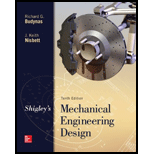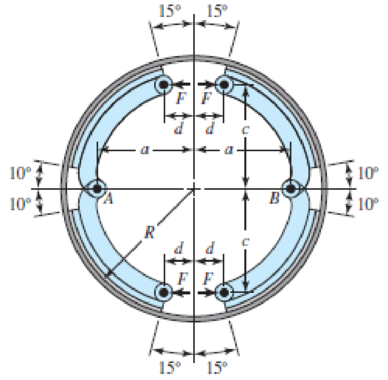
Concept explainers
The figure shows a 400-mm-diameter brake drum with four internally expanding shoes. Each of the hinge pins A and B supports a pair of shoes. The actuating

Problem 16–4
The dimensions in millimeters are a = 150, c = 165, R = 200, and d = 50.
(a) Determine the maximum actuating force.
(b) Estimate the brake capacity.
(c) Noting that rotation may be in either direction, estimate the hinge-pin reactions.
(a)
The maximum actuating force.
Answer to Problem 4P
The maximum actuating force is
Explanation of Solution
Write the expression for moment of frictional forces.
Here, coefficient of friction is
Write the expression for moment of normal forces.
Here, moment of normal forces is
Write the expression for actuating force.
Here, actuating force is
Conclusion:
Calculate
Substitute
Substitute
Substitute
Thus, the maximum actuating force is
(b)
The total braking capacity.
Answer to Problem 4P
The total braking capacity is
Explanation of Solution
Write the expression for torque applied by primary shoe.
Here, braking torque applied by primary shoe is
Write the expression for moment of frictional forces.
Here, moment of frictional forces for secondary shoe is
Write the expression for normal forces for secondary shoes.
Here, normal forces for secondary shoes is
Write the expression for actuating forces.
Here actuating force is
Write the expression\n for braking torque on left hand side shoe.
Write the expression for total braking torque.
Here, total braking torque is
Conclusion:
Substitute
Substitute
Substitute
Substitute
Substitute
Substitute
Thus, the total braking capacity is
(c)
The horizontal reaction on primary shoes.
The vertical reaction on primary shoe.
The horizontal reaction on secondary shoes.
The vertical reaction on secondary shoe.
The resultant reaction.
Answer to Problem 4P
The horizontal reaction on primary shoes is
The, the vertical reaction on primary shoe is
The horizontal reaction on secondary shoes is
The, the vertical reaction on secondary shoe is
The resultant reaction is
Explanation of Solution
Write the expression for horizontal reaction on hinge pin for primary shoe.
Here, horizontal reaction is
Write the expression for vertical reaction on hinge pin for primary shoe.
Here, vertical reaction is
Write the expression for horizontal reaction on hinge pin for secondary shoe.
Here, horizontal reaction on hinge pin for secondary shoe is
Write the expression for vertical reaction on hinge pin for secondary shoe.
Here, vertical reaction on hinge pin for secondary shoe is
Write the expression for net horizontal reaction.
Here, net horizontal reaction is
Write the expression for net vertical reaction.
Here, net vertical reaction is
Here, resultant reaction is
Conclusion
Substitute
Thus horizontal reaction on primary shoes is
Substitute
Thus, the vertical reaction on primary shoe is
Substitute
Thus horizontal reaction on secondary shoes is
Substitute
Thus, the vertical reaction on secondary shoe is
Substitute
Substitute
Substitute
Thus, the resultant reaction is
Want to see more full solutions like this?
Chapter 16 Solutions
Shigley's Mechanical Engineering Design (McGraw-Hill Series in Mechanical Engineering)
- Q10/ A single block brake, as shown in figure, has the drum diameter 250 mm. The angle of contact is 90° and the coefficient of friction between the drum and the lining is 0.35. The other dimensions are as follows: a = 200 mm, 1 = 400 mm and b = 100 mm. If the torque transmitted by the brake is 70 N-m, find the force F required to operate the brake. ock is Irum.arrow_forwardFor the drum brake shown in the following figure, there is an inner rim diameter of 280 mm and dimension a = 90 mm. The shoes have a face width of 30 mm. The force exerted by the cylinder hydraulic is 1000 N and the average coefficient of friction is 0.3. Determine: a) The maximum pressure in each shoe; b) The braking torque; c) Reactions resulting from the pivot pin;arrow_forwardQ6/ A differential band brake has a force of 220 N applied at the end of a lever as shown in Figure. The coefficient of friction between the band and the drum is 0.35 The angle of lap is 180°. Find the maximum and minimum tension in the band, when a torque of 600 N-m is applied to the drum which rotates 150 clockwise. 220 N A 100- 200 All dimensions in mn. (Good Luck) دحسن حمودي مهدي مدرس المادة ASO porte e axis min er bos plg neowled 30 id 40 metni im - 214. arliarrow_forward
- The roughly position of the automobile jack shown in the figure is a square screw with a single blade at both ends. ABC is controlled by a bolt (right-hand threaded in A, left-handed in C). square of the bolt screw has a pitch of 2.5 mm and an average diameter of 9 mm. between the bolt and the jack limbs The coefficient of static friction is 0.15, taking into account the position and load shown, you can use the jack Find the magnitude of the torque that must be applied to raise it.arrow_forwardThe open V-belt drive system shown in Figure 3 has a groove angle of 30° and is used as a speed booster. The input shaft rotates at 500 rpm and has a sheave with a pitch diameter of 7.218 in and the output shaft has a sheave with a pitch diameter of 3.609 in. The center distance between the two shafts is 15.01 in. The coefficient of friction is 0.25 and the maximum tension in the tight side of the belt is 300 lb. Determine; 1. The angular velocity of the output shaft. 2. The belt wrap on the input and output sheaves. 3. The belt perimeter length. 4. The length of span between sheaves. 5. The maximum power transmitted by the belt if its mass is 0.04 slug/ft. [Hint: P 8 (T-T2)xv P in horse power (hp), T, and T, in (lb). v in (ft/min)]. 33000 Belts and Chains 4-d. sin-4-d, 20 Figure 3arrow_forward4.) A flat belt makes contact with an 16 in. diameter pulley through half its circumference. If the coefficient of friction is 0.45 , and a torque of300ft−bsis to be transmitted, calculate the belt tensions. (please type answer not write by hend)arrow_forward
- The figure shows an internal rim-type brake having an inside rim diameter of 300 mm and a dimension R 5 125 mm. The shoes have a face width of 40 mm and are both actuated by a force of 2.2 kN. The drum rotates clockwise. The mean coefficient of friction is 0.28. a. Find the maximum pressure and indicate the shoe on which it occurs. b. Estimate the braking torque effected by each shoe, and find the total braking torque. c. Estimate the resulting hinge-pin reactions. 30°- 30°. R 120° 120° Pin Pin 30° 30° Figure 3: An internal rim-type brakearrow_forwardForm the figure shown, a flexible belt placed around a rotating drum of 4-inch radius acts as a brake when the arm ABCD is pulled down by the force P. The coefficient of kinetic friction between the belt and the drum is 0.7. What force P that would result in a braking torque of 400 lb. in., assuming that the drum is rotating counterclockwise. Neglect the weight of the brake arm. 60° 4 in. 60° B 1-2-4² m-4-2m- in.- 4 in. in.- D Рarrow_forwardProblem 4 The maximum band interface pressure on the brake shown in the figure is 620 kPa. Use a 350 mm diameter drum, a band width of 25 mm, a coefficient of friction of 0.30, and an angle-of-wrap of 270. Find the band tensions and the torque capacity. Rotation P₂arrow_forward
- The two square-jaw grips have the dimensions shown in the figure and are made of mild steel. The clutch is designed to transmit a power of 1.8 kW at 600 rpm. Calculate the surface pressure and shear stresses on the wedges and jaws. they all in mmarrow_forwardForm the figure shown, a flexible belt placed around a rotating drum of 4-inch radius acts as a brake when the arm ABCD is pulled down by the force P. The coefficient of kinetic friction between the belt and the drum is 0.7. What force P that would result in a braking torque of 400 lb . in., assuming that the drum is rotating Neglect the weight of the counterclockwise. brake arm. 60° 4 in. 60° A B C -2 in.²4in. 2 in. 42×-| -2 D Parrow_forwardThe figure shows an internal rim-type brake having an inside rim diameter of 11in and a dimension R of 3.5 in. The shoes have a face width of 1.25 in. Find the braking torque and the maximum pressure for each shoe if the actuating force is 205 Ibf, the drum rotation is counterclockwise, and f=0.32. The maximum pressure on the right-hand shoe parp is [ 16.99] @ psi. The maximum pressure on the left-hand shoe pa| H is [100.813 | @ psi. The torque on the right-hand shoe Tgis [ .056 | @ kipin. The torque on the left-hand shoe T is [ .332| @ kipin. Total braking torque Tiotal s [-3887] @ Kip-in.arrow_forward
 Elements Of ElectromagneticsMechanical EngineeringISBN:9780190698614Author:Sadiku, Matthew N. O.Publisher:Oxford University Press
Elements Of ElectromagneticsMechanical EngineeringISBN:9780190698614Author:Sadiku, Matthew N. O.Publisher:Oxford University Press Mechanics of Materials (10th Edition)Mechanical EngineeringISBN:9780134319650Author:Russell C. HibbelerPublisher:PEARSON
Mechanics of Materials (10th Edition)Mechanical EngineeringISBN:9780134319650Author:Russell C. HibbelerPublisher:PEARSON Thermodynamics: An Engineering ApproachMechanical EngineeringISBN:9781259822674Author:Yunus A. Cengel Dr., Michael A. BolesPublisher:McGraw-Hill Education
Thermodynamics: An Engineering ApproachMechanical EngineeringISBN:9781259822674Author:Yunus A. Cengel Dr., Michael A. BolesPublisher:McGraw-Hill Education Control Systems EngineeringMechanical EngineeringISBN:9781118170519Author:Norman S. NisePublisher:WILEY
Control Systems EngineeringMechanical EngineeringISBN:9781118170519Author:Norman S. NisePublisher:WILEY Mechanics of Materials (MindTap Course List)Mechanical EngineeringISBN:9781337093347Author:Barry J. Goodno, James M. GerePublisher:Cengage Learning
Mechanics of Materials (MindTap Course List)Mechanical EngineeringISBN:9781337093347Author:Barry J. Goodno, James M. GerePublisher:Cengage Learning Engineering Mechanics: StaticsMechanical EngineeringISBN:9781118807330Author:James L. Meriam, L. G. Kraige, J. N. BoltonPublisher:WILEY
Engineering Mechanics: StaticsMechanical EngineeringISBN:9781118807330Author:James L. Meriam, L. G. Kraige, J. N. BoltonPublisher:WILEY





